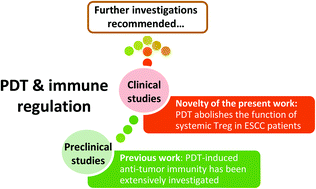Photodynamic therapy downregulates the function of regulatory T cells in patients with esophageal squamous cell carcinoma†
Abstract
Photodynamic therapy (PDT) by selective photosensitization of cancer cells and subsequent laser application results in local tumor necrosis. However, the effects of PDT on immune function, which may depend on the type of immune response, are controversial. We investigated the immunological changes induced by PDT and the effect of PDT on level and function of regulatory T cells (Treg) in patients with invasive esophageal squamous cell carcinoma (ESCC). We analyzed patient's blood samples before and after PDT. Blood CD4+CD25+CD127−FoxP3+ Treg levels were quantified by FACS, and Treg function was evaluated by coculture proliferation assays with T effector (Teff) cells. We found that PDT abrogated the suppressive capacity of peripheral Treg (Days 7 and 14, p = 0.016) but had no effect on Treg levels. The effect of PDT on Treg function at Day 7 was accompanied by slight but statistically significant increases in peripheral neutrophil granulocytes (p = 0.035) and monocytes (p = 0.013) and a statistically significant increase (approximately 18-fold) in serum IL-6 levels (p = 0.008). In conclusion, PDT abolished Treg function, possibly due to increased IL-6 levels in treated ESCC patients. This may be crucial for an improved therapeutic outcome.


 Please wait while we load your content...
Please wait while we load your content...